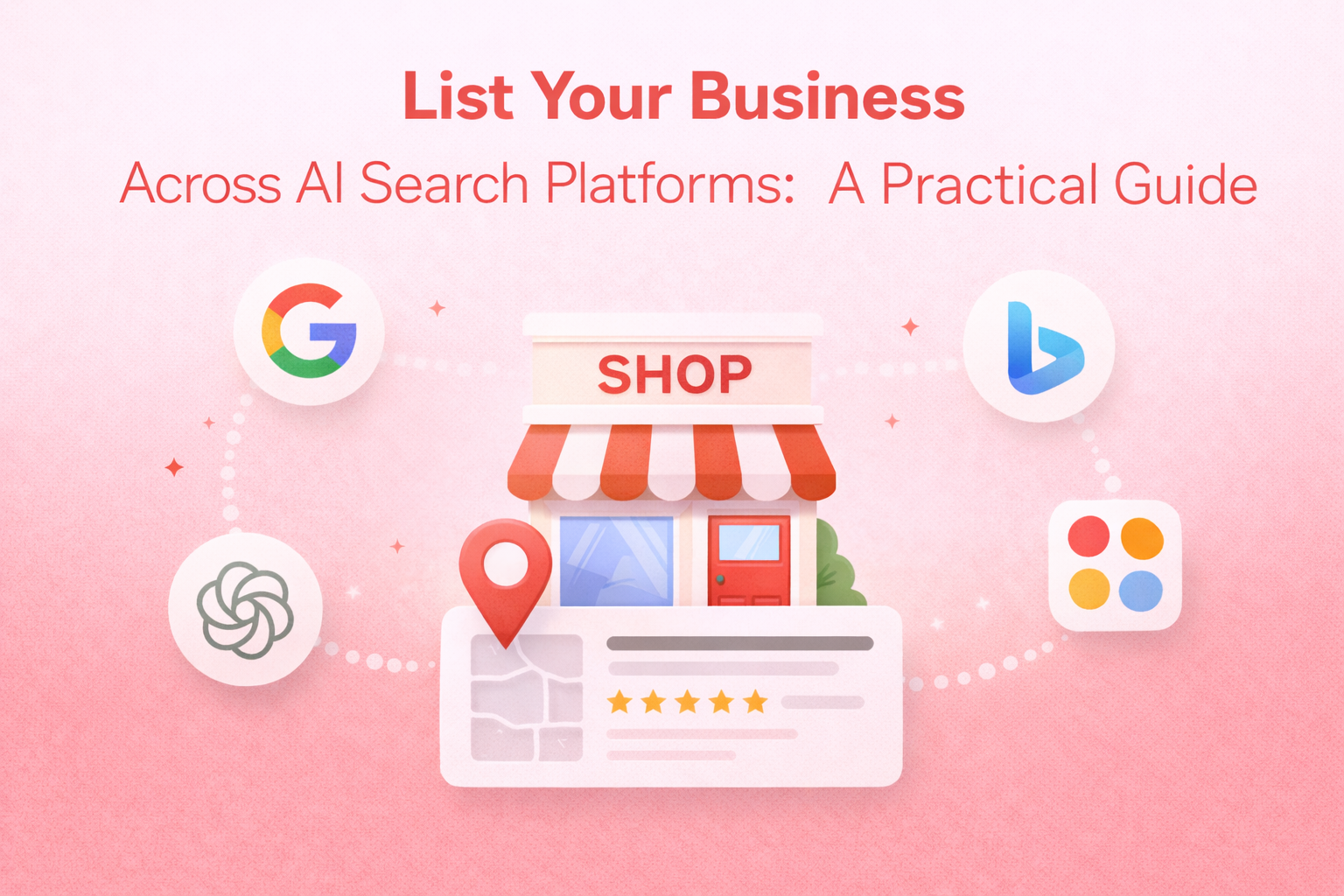AI search platforms surface answers directly inside assistants and chat experiences,
so businesses that structure data, verify profiles, and expose clear signals earn
disproportionate visibility and conversions. This guide shows exactly how to list
and optimize your business across the major AI search surfaces, with a pragmatic,
SMB-friendly checklist for each.
What AI search is
AI search combines large language models with live data to generate direct, cited
answers instead of 10 blue links, shifting discovery from clicks to conversations.
Visibility now depends on structured data, verified profiles, and consistent facts
that agents can safely reuse.
Why it matters now
- Zero-click answers: Assistants resolve intent in-chat; if your facts aren’t machine-readable, you’re invisible.
- Trust and eligibility: Verified, consistent data becomes a quality signal that platforms prefer to quote.
- Compounding effects: Clean structure feeds every model that ingests the open web and knowledge graphs.
Success pillars
- Entity consistency: Use the same legal name, address, phone, categories, and URLs everywhere.
- Structured data: Add schema.org markup, feeds, and sitemaps; expose hours, pricing, and availability.
- Authorship and citations: Publish fact pages that assistants can cite verbatim, with dates and anchors.
- Freshness: Keep hours, inventory, policies, and prices up to date; stale data gets down-ranked.
- Compliance: Provide privacy, returns, warranty, and support routes to reduce platform risk flags.
Master business profile checklist
- Primary “About/Fact” page with NAP (name, address, phone), services, service areas, and FAQs.
- Organization schema with sameAs links to official profiles (LinkedIn, Crunchbase, GitHub, app stores).
- LocalBusiness schema (or relevant subtype) for each location; include hours and geo coordinates.
- Product or Service schema for key offers; include pricing, images, and availability.
- FAQ schema answering high-intent queries; use short, quotable sentences.
- XML sitemap and an /updates or /press page with dated announcements.
Platform-by-platform actions
Google and classic SEO foundations
- Verify Google Business Profile per location; align categories and services; add products and Q&A.
- Implement Organization, LocalBusiness, Product, Service, FAQ, and Review schema across key pages.
- Publish location pages with embedded maps, hours, reviews, and unique content to earn citations.
Microsoft Copilot/Bing
- Set up Bing Places and ensure parity with Google Business Profile data.
- Submit URLs in Bing Webmaster Tools; enable IndexNow for fast updates and leverage sitemap pings.
- Add detailed “About” and “Pricing” sections that Copilot can quote with links.
Apple and Siri
- Claim Apple Business Connect; verify locations; add categories, hours, photos, and actions.
- Keep NAP consistent with your site and other profiles; update special hours and closures promptly.
ChatGPT ecosystem
- Publish a machine-readable “Facts” page with canonical company details and services; keep it current.
- For commerce, prepare a compliant product feed and clear policies; pursue merchant eligibility where relevant.
- Create authoritative guides and FAQs that can be cited; use clear headings and single-answer paragraphs.
Perplexity and answer engines
- Maintain high-quality, cited pages with unambiguous claims and sources; add author bios and dates.
- Build topic hubs that aggregate your research, datasets, and white papers for easy quoting.
LinkedIn and professional graphs
- Complete Company Page with services, specialties, and lead gen forms; keep leadership bios updated.
- Cross-link key articles and case studies; pin featured content with dates and outcomes.
Yelp, industry, and local directories
- Claim listings; standardize categories; add menus/services, price ranges, and photos.
- Encourage authentic reviews; respond professionally; keep attributes like “wheelchair accessible” updated.
Data aggregators (US)
- Ensure accuracy in Neustar/Localeze, Foursquare, Data Axle, and TomTom/Here for downstream maps/apps.
- Use a listings manager only if you can audit outputs; avoid duplicate or conflicting entries.
Website implementation blueprint
1) Information architecture
- Create canonical pages: /about, /contact, /locations, /services, /pricing, /faq, /press, /privacy, /returns.
- Add a “Facts” anchor section with NAP, founding year, leadership, and identifiers (VAT/EIN if appropriate).
2) Schema essentials
- Organization with logo, sameAs, foundingDate, address, and contactPoint.
- LocalBusiness (per location) with openingHoursSpecification and geo.
- Product/Service with offers (priceCurrency, price, availability) and descriptive images.
- FAQPage for 6–10 intent questions; keep answers ≤50 words and current.
3) Technical signals
- Clean canonical tags; lastmod in sitemaps; IndexNow or rapid pinging on updates.
- Fast Core Web Vitals; compress hero images; serve WebP/AVIF; preconnect critical domains.
- Robots.txt allows key folders; block duplicates and staging.
4) Content for citations
- “Definitive” overview posts with clear takeaways, bullet points, and dated revisions.
- Case studies with metrics, method, and client quotes; add structured Review or HowTo when applicable.
- Short, quotable summaries at the top of long pages; use plain, unambiguous wording.
Local and multi-location tactics
- Unique content per city page: localized testimonials, nearby landmarks, service coverage, and pricing notes.
- Embed maps and driving/parking details; add GMB/Bing reviews widgets.
- Track NAP consistency quarterly; fix strays and duplicates promptly.
E-commerce and agentic readiness
- Maintain a product feed with IDs, titles, descriptions, price, availability, and images; update frequently.
- Expose policies (shipping, returns, warranties) and contact routes to reduce risk flags.
- Prepare checkout endpoints and delegated payment support if you plan to sell in chat interfaces.
Measurement and QA
- Monitor assistant referrals as direct/unknown with landing-page UTMs; annotate content updates.
- Track coverage: pages indexed, schema validity, GBP/Bing completeness, and directory accuracy.
- Review logs for crawl errors and spike fixes; maintain a monthly freshness calendar.
Quick-start 30-day plan
- Week 1: Audit NAP and profiles; publish “Facts” page; implement Organization and LocalBusiness schema.
- Week 2: Build /services and /faq; add Product/Service schema; verify Google/Bing/Apple profiles.
- Week 3: Create two authority posts with clear citations; ship sitemap, IndexNow, and image optimization.
- Week 4: Claim top directories; request reviews; fix inconsistencies; publish a press/updates item.
Common pitfalls to avoid
- Inconsistent names and categories across platforms causing confidence drops and suppressions.
- Over-templated pages with thin, duplicate content that assistants refuse to cite.
- Stale hours, prices, or stock leading to user complaints and down-ranking.
- Missing policies or contact info reducing eligibility for answer inclusion.
Reusable templates
Facts section (drop into /about)
- Company: WebThreeX
- Legal Name: WebThreeX LLC
- Founded: 20XX
- Headquarters: City, Country
- NAP: Address – Phone – Support Email
- Services: A, B, C
- Identifiers: VAT/EIN, Registration No.
- Official Profiles: LinkedIn, GitHub, Crunchbase, App Stores
- Last updated: YYYY-MM-DD
FAQ seed questions
- What services does <Brand> provide and where?
- What are <Brand>’s support hours and response times?
- What is <Brand>’s pricing model and typical timelines?
- How can customers contact <Brand> for sales or support?
- What industries has <Brand> served and what outcomes were delivered?
Action checklist
- Canonical facts published and marked up.
- Major profiles claimed and verified (Google, Bing, Apple, LinkedIn, Yelp/industry).
- Consistent NAP and categories across all listings.
- Product/Service schema on key offer pages; FAQ schema live.
- Sitemaps and rapid-update signals enabled; images optimized.
- Quarterly audits for freshness, accuracy, and review velocity.


